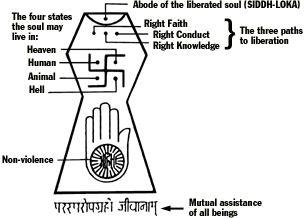Symbol

A structural overview
BCE | 23 Tirthankaras ↓ | |||||
-6th | Mahavira24th Tirtankara | |||||
↓ | ↓ | ↓ | ↓ | ↓ | ||
1st | Shvetambara | Digambara | ||||
Murtipujaka (Mandirmargi) | Amurtipujaka (Sadhumargi) | |||||
2nd | ||||||
3rd | ||||||
4th | ||||||
5th | Yapaniya | Mula Sangh (c.430 CE) └► Nandi Gana
| ||||
6th | ||||||
7th | Kashtha Sangh └► Nanditat Gaccha └► Mathura Sangh └► Bagada Gaccha └► Lata-bagada Gaccha | |||||
8th | ||||||
9th |
| |||||
10th | Vrahada Gaccha (937 CE) | |||||
11th | Kharatara Gaccha (1024 CE) |
└► Sena Gana | ||||
12th |
Tristutik Gaccha (1194 CE) Upakesha Gaccha | |||||
Oswal ► | ◄ Oswal | |||||
13th | Tapa Gaccha (1228 CE) Ancala Gaccha | |||||
14th | ||||||
15th | Lonka Gaccha | |||||
16th | Parshwachandra Gaccha | Taran Panth (Samaiyapanth) | ||||
17th | Bispanth Digambar Terapanth | |||||
18th | Shvetambar Terapanth | Guman Panth | ||||
19th | ↓ | |||||
20th | Nav Terapanth Kavi Panth | Pandit Todarmal Smarak Trust Kanji Swami Panth
| ||||
Jainism
also called Jinism, or known as Arhat Dharma (in ancient time)
Jainism is the one of the oldest religious traditions in India, and perhaps the world. It is based on the principles of non-violence, non-possession, self-control and strenuous effort in pursuit of spiritual goals.
Jainism is one of the oldest of the three major religions that developed in the Indian sub-continent before the Common Era. The exemplary figure of the Jains is Mahavira, an older contemporary of Buddha. Mahavira is often described by non-Jains as the founder of Jainism. However, Mahavira is the last of the twenty-four Tirthankaras (spiritual path founders) or Jinas (self-conquerors) of our era, and the successor of the religious teacher, Parsvanath.
Today there are over 5 million Jains in India and sizable numbers in Europe, USA, Canada, East Africa, Australia, Japan and Singapore. The majority of Jains are engaged either in business or in professions such as law, medicine, engineering, and journalism.
The Jain community and tradition can be seen as a microcosm of Indian society and ways of thought. Scholarship within the Jain tradition has spanned centuries and has covered such fields of inquiry as science, mathematics, logic, religion and philosophy.
http://www.jainstudies.org/jain-introduction.php
Jainism believes in a cyclical nature of the universe, a universe without a beginning, without an end and without a creator.
It is the religion of Jina, also called the religion of Ahimsa, enunciated by 24 Tirthankaras, last ones known as Mahavira (~ 599 BC), a contemporary of Buddha, and Parsva (~850 BC). Both found acceptance as historic persons. The appearance of the 22 predecessors reach for eons.
Mahavira propounded Jainism by giving central importance to the soul, with high emphasis on conquering the inner enemies.
Jainism teaches a way to spiritual purity and enlightenment through a disciplined mode of life and is founded upon the tradition of Ahimsa, non-violence to all living creatures.
The five ethics of Jainism are:
- Ahimsa (non-violence),
- Satya (pursuit of truth),
- Asteya (non-stealing and honesty),
- Aparigraha (non-possession and non-attachment) and
- Brahmacharya (celibacy).
These are also called the five Vratas (vows) and have to be realized by mind, speech and body.
A distinction is drawn between these ethics or Vratas for the ascetic (saints, monks & nuns) and for the layman (sravak).
The saints have to practice the Vratas rigorously.
But the sravakas have to and can practice with lesser degree according to their worldly life.
Another important fundamental concept of Jainism is Anekanta.
It states that reality is complex. It can be looked at from different point of views. Each point of view gives the picture of reality which is as valid and real as the picture of reality received from other point of view.
Jainism has contributed to the philosophy of life in its insistence that the pathway to perfection is threefold:
- Samyak-Darshana (right faith/right understanding)
- Samyak-Jnana (Right knowledge) and
- Samyak-Charitra (right conduct).
Jiyo Aur Jine Do (live and let live) is the main slogan of Jainism which was given by Bhagwan Mahaveer about two thousand six hundred years ago.
Beginning in the 7th-5th century BCE, Jainism evolved into a cultural system that has made significant contributions to Indian philosophy and logic, art and architecture, mathematics, astronomy and astrology, and literature.
Along with Hinduism and Buddhism, it is one of the three most ancient Indian religious traditions still in existence, it is not a Hindu sect or Buddhist heresy, as earlier scholars believed.
Jainism has two principal quite different branches, the Digambara (Sanskrit 'Sky-clad', naked) and the Svetambara (Sanskrit 'White robed') Jains. The male Digambara ascetics wear no clothes, the Svetambara wear white robes.
Digambara worship idols in temples, whereas Svetambara in general are not practising idolatry and do not have temples.
More informations on Jainism at BBC Homepage on Religion & Ethics: